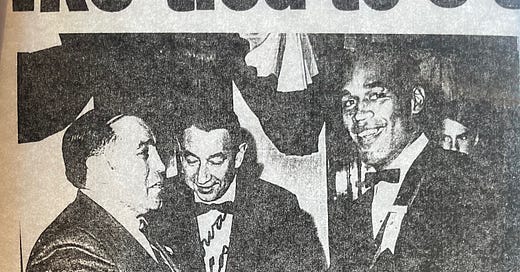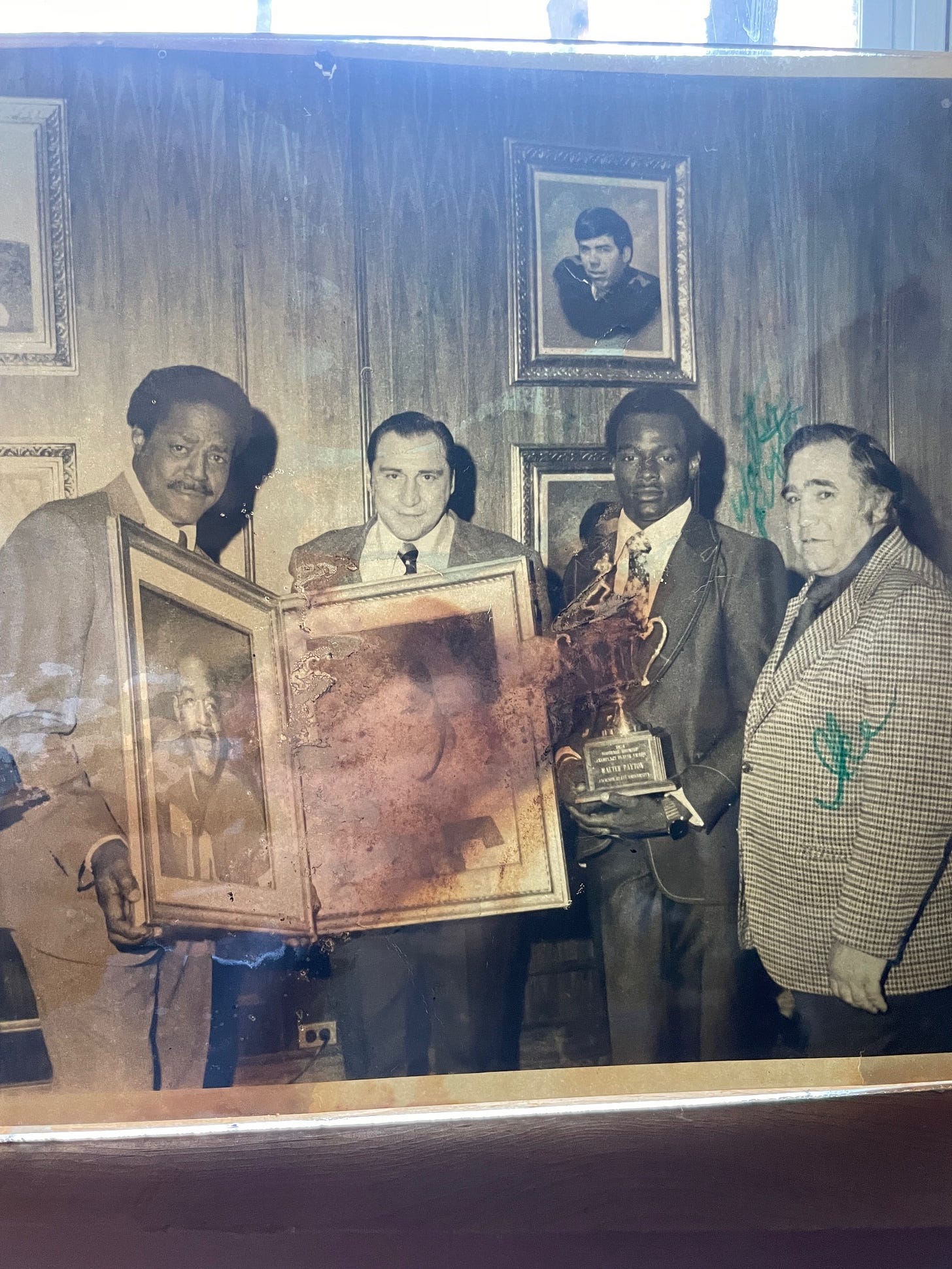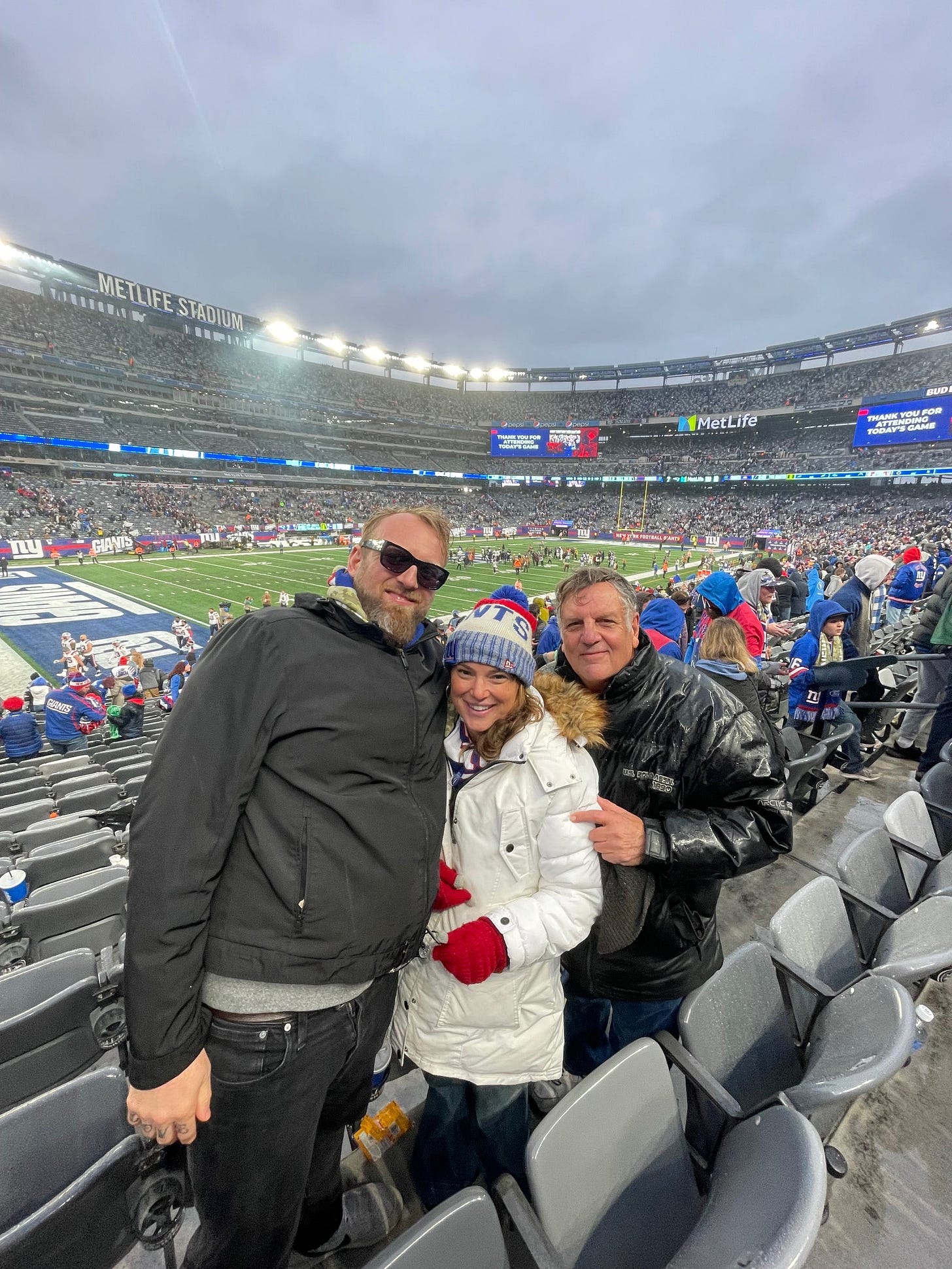Last week I shared an old essay with you because, owing to the holiday, I was short on time. This week, I share another old essay with you because it seemed apropos.
Just as last week’s essay, the root of this week’s story is struggle (as is the root of almost any good story). Last week, it was predicated on my own struggle with the why of Thanksgiving. This week, it’s the why of sports.
My entire life, sports fandom has been essential to who I am. And there is no bigger sports imprint on my DNA than football. I was raised in a football-crazed family, by a father obsessed with the New York Giants and a grandfather who played professional football and coached at a variety of high schools and Pop Warner programs around North Jersey for years. I was raised to understand that Sundays were the Lord’s day, only our lords were Mark Bavaro, Stephen Baker, and Joe Morris, later Eli Manning, Michael Strahan, and Justin Tuck.
For as long as I can remember, a very few things meant more to me than my love of football (college basketball a close second) and my love of the Giants.
But as my kids grow, I find myself giving less and less of a damn about all sports, especially football. It’s a wane that has been aided no doubt by a decade of futility by my beloved Giants. But also, it’s a disinterest rooted in the fact that would simply rather spend Sunday afternoons with my kids, doing something that enriches us all. And sometimes, that’s sitting on the couch together, watching football. But more often, it’s being outside, doing a puzzle, coloring, playing with toys, riding bikes, being together.
Like they have with almost everything else in my life, my kids have made me realize that football doesn’t actually mean anything.
Except, it does.
And here’s where the old essay comes in. Just because I give less of a shit about football than I ever have before doesn’t mean I don’t realize the ways it brings people together.
This weekend, my sister and I surprised our old man for his seventieth birthday with a one-day trip to the place he took us so many times when we were kids; a New York Giants game. We left before dawn, caught a sunrise flight from Raleigh-Durham International to Newark Liberty, and got home after midnight. We ate beautifully and shared laughs and memories, and created an entirely new memory the three of us will never forget.
If they’re lucky, fathers and their children only get one or two things to truly share over a lifetime. For me and my old man, it’s Jimi Hendrix and the New York Giants. And that’s why, even if I don’t give much of a shit about what’s happening on the field anymore, I don’t think I’ll ever stop being a fan.
Anyway, that was a long intro to a long story about my own childhood in the rock-hard seats at Giants stadium. Some of you may have read this essay before. Most of you haven’t. I hope you enjoy it.
Go GMen.
“317”
High on my rib cage, near the pit of my left arm is a small tattoo, four or so inches in length, written in almost hieroglyphic font. Its form is difficult to ascertain and somewhat alien to the eye. But when looked at closely, it becomes clear that my ribs bear the number 317.
Those who’ve seen the tattoo often ask if that is the telephone area code of where I grew up.
“Nah,” I tell them. “That’s 609.”
“Oh. It’s a religious thing?” They’ll say. “Like ‘John 316?’”
“No. You see those have colons — like John 3:16 — to separate the chapter and verse. Anyway, I’m an atheist.”
“Oh. Well, what is it?”
“It’s nothing.”
“Oh.”
What I often don’t mention is how it’s a memorial to my grandfather, to my father and, oddly enough, to Giants Stadium, the old concrete monolith who stood astride the soft ground of New Jersey’s Meadowlands for over three decades; how it’s the section where, for three decades, our family had season tickets for the New York Giants.
What I don’t mention is how it was in that stadium, amongst eighty-thousand beer-chugging, hot-dog-eating football people, just a few hundred feet from Phil Simms, Lawrence Taylor, Michael Strahan, Justin Tuck, Eli Manning, and hundreds upon hundreds of other New York Giants, that I learned how to be a man.
****
Throughout the 1950s, 60s and 70s my grandfather — a stout Italian-American man known simply as “Ike” — was something of a civic celebrity in Jersey City, New Jersey. He held myriad political, educational and city-sanctioned positions including the director of public works, dean of students at a local high school, city football coach and, most importantly in the history of my family, director of a medium-sized baseball stadium.
The story of Ike is one of endless anecdotal ramblings. The tales of his alleged friendship with legendary football coach Vince Lombardi were never in short supply. The picture of him shaking O.J. Simpson’s hand the night Simpson won the Heisman Trophy, legendary sportscaster Howard Cosell standing beside the two, hangs somewhere in most of my relatives’ homes. The tale of the time Ike was on a podium in Jersey City seated next to former President Gerald Ford and the words “Hey who’s that guy talking to Ike?” were overheard in the crowd is told at every holiday dinner. It was hard to find someone in or near Hudson Country, New Jersey who didn’t know Ike personally, by name or by reputation.
For a time, Ike ran Roosevelt Stadium, a 24,000-seat bowl situated on the west side of Jersey City that was used for baseball (as a member of the Montreal Royals, Jackie Robinson made his professional debut at the stadium as they took on the Jersey City Giants), high school football, and as a venue for rock and roll concerts along with other various city and countywide events.
In 1973, the New York Football Giants were in the process of moving from their then home of Yankee Stadium to the recently demolished Giants Stadium in East Rutherford (with short stints at the Yale Bowl and Shea Stadium in the interim) and they had nowhere to practice. I don’t know where, when or how it happened but at some point in that span, the Giants' front office got in touch with Ike, inquiring whether the team could use Roosevelt Stadium as a practice facility while Giants Stadium was being constructed in the nearby Meadowlands.
Gameday. Mid-fall. The roads were often a little moist with the previous night’s precipitation. Autumn in New Jersey is very wet season. The leaves were a palette of browns, yellows and reds. My father and I would wake early, pack the car with the sodas and sandwiches my mother had prepared and hit the road, often while the sun was still stretching to get up. We had to start as early as possible as our long routine consisted of driving up the Garden State Parkway from the southern Jersey Shore, battling the scads of Sunday tourists flocking to lower Manhattan, picking Ike up in at his home in the Heights neighborhood of Jersey City, getting ourselves down the 1 & 9 highway, over to Route 3, and into the parking lot at least three hours before kickoff.
By the time we arrived, the parking lots that stretched out in the shadow of the stadium were nearly full. Footballs soared through the sky, cutting through the smoke from a thousand hibachi grills while thumping loud music intermingled with the pregame show on WFAN that poured out of the open windows of everyone’s parked cars, trucks, and RVs.
But while most pre-gamers spent their mornings drinking beer out of their trunks and sucking down Sabrett hot dogs, our tailgates more closely resembled an Italian-American family dinner. Chicken parm sandwiches, soppressata and mozzarella, olives, antipasto, fresh loaves of bread, vine-ripened tomatoes.
After the tailgate, we’d make our way across the parking lot, through the gates, up the spiral walkways and into our seats. Hugs and salutations were exchanged with those seated around us, those families whom we sat amongst season after season.
Ike was referred to as “Coach” which referenced his penchant for calling, with unbelievable accuracy, every single play in a game, moments before it happened.
It was shocking to those around us the way Ike had some clairvoyant passage into the minds at work on the field of play. But to me and my father it was just Ike doing what he did best: talking football.
Often a faceless shout would come from the left or right, above or below, “Hey Coach, what are they gonna do here?”
When Ike was right, as he almost always was, the rows around us would burst into cheers and laughter and Ike would just sit, not smiling, his eyes locked on the field of play, his mouth chewing away at a small salami sandwich he inevitably snuck in to the stadium.
Ike played four years at Columbia University when Ivy League football was a destination for some of the nation’s best high school players. He followed that with a short stint with the NFL’s Boston Yanks (who would later become, in a very convoluted fashion, the Indianapolis Colts). He also spent a year or two or three bouncing around AFL teams and minor league clubs. For decades after that, he helmed the football programs at various high schools around North Jersey.
There was nothing in life Ike knew more than football. And though the game had evolved greatly in the years since he’d left the sideline, football was and always will be, predicated on a few very simple ideas that Ike knew intimately, truisms that will never fall out of fashion.
Pick up yards on first down. Mitigate your mistakes. Set the edge.
My father—or “Doc” as he was known in 317, due to his MD and therefore his ability to make a diagnosis right in the stands—had a far more inquisitive way of watching. When he wasn’t being inundated with medical questions from the older crowd in 317, he would spend most of the game quizzing me, teaching me about the subtlety and beautiful nuance of such a violent game, asking what I thought the coach might call in this situation or that, or imploring me to explain the reasoning behind a certain penalty.
At the game’s conclusion, we’d plod down the spirals walking in unison with the hordes of other fans who were, depending on the game’s outcome, exhausted or elated, out past the arena where the Devils and the Nets played, back to the car, back into traffic, up Route 3, down 1 & 9, to the Heights to drop Ike off, down the Parkway, and, if we were lucky, home in time for the kickoff of the primetime game. Game days were long and exhausting.
Game days were perfect.
We flew under the radar for a few years after Ike died, his tickets being forwarded to the executors of his will and then being procured and distributed by “Ike” among our family. Somewhere in there, the Giants ticketing office found out about Ike’s death and immediately rescinded our tickets, as their policy stated that the rights to season tickets were not allowed to be willed to next-of-kin. As the waiting list for season tickets stretched well past two decades back then, it was one of the only ways to get tickets into the hands of patient fans.
Over the next handful of years, my father and I scored season tickets through ticket brokers. The cost was roughly the same but we’d never know, year-to-year or even game-to-game, where we’d be sitting. Sometimes we’ll head to Section 112 or Section 320. Sometimes we’d recognize a familiar old face walking up the spirals or at the beer stand and we’d nod and wave and chat briefly about the Giants while my father quickly diagnosed yet another ailment for an old friend. We broke the news more than a few times to old sectionmates of Ike’s passing. One man began to weep when he heard the news.
But just as many memories were built in 317, my father and I soon developed a new unspoken tradition which would always ensue as soon as we found our seats for the day: orient ourselves in our new environs, find 317 and see who was sitting in our old seats.
In 2010 the Giants — in partnership with their roommates the New York Jets — opened the shiny new MetLife Stadium. Gone was the sturdy, stoic Giants Stadium. Gone were the old scoreboards, the herculean speaker that jutted out over an entire upper end zone section and the cold, hard plastic seats. Gone was the hallowed field that, according to urban lore, doubled as Jimmy Hoffa’s final resting place. Gone were the famous spirals that led to the upper levels. Gone was Section 317.
It was also the first year in decades that we didn’t get season tickets. Due to new jobs, new babies and life, the Cowboys game was the only Sunday both my father and I were free. We got great seats twenty rows or so off the field. But just as the last few years in the old building were unfamiliar to me, so was this Sunday; new stadium, new seats, new people, new faces. For a while, I attributed it to the virgin setting. Then I told myself that I was just growing up. I resigned the memories to the magic of childhood and hoped that the kid in the seat near me was sitting there, wedged in between the two giants in his life, discovering without knowing it how to be a good man and a decent human being. After all, that’s what going to a football game is all about.
****
In the ensuing years, before moving from New York City, I’d trek out to my parents’ home on Eastern Long Island on fall Sundays. They left the Jersey Shore sometime when I was in college, wanting to be closer to my sister, who lived on Long Island, and me, in Brooklyn, as my mother battled the cancer that would eventually kill her.
I’d hop on the Long Island Rail Road early in the morning and take the Ronkonkoma line out to its namesake stop where my father would wait in his little midlife sports car that I pretended was a rocketship. We’d take the twenty-five-minute drive to my parents' low-slung house and talk about the Giants. We’d play Sunday morning coach and discuss who needs to go, who needs to sign, which young players look good within the division. We’d talk about my mother and how her chemo treatments were going. We’d talk about my sister’s babies and how they kept my parents young.
Eventually, we’d pull up to their house where my mother would be waiting in the kitchen, pots of gravy bubbling, salads crisp and macaroni and meatballs steaming next to fresh piles of mozzarella and bottles red wine. She’d instruct us into the spare bedroom, where the house’s only television sat on a tall dresser, and my father and I would lounge on the bed, eating from a constant revolution of trays brought in by ma. The full-size mattress made for a tight squeeze as two grown men fought and jockeyed for position, passing bread and antipasti, olives and root beer floats back and forth. Our elbows would rub and our knees knocked into each other, just as they did in the ever-shrinking seats that always waited for us in Section 317.
****
I’m sure I’ll get more. There are at least four or five major pieces that I’ve been mulling for years. But for now, the eighteen tattoos smattered across my body represent eleven very real times and places and people in my life that even without the aid of permanently defacing my body I could never possibly forget.
The wings of a pixie float inside my bicep; the strong, unbending lighthouse of my childhood home runs down my forearm; a brief quote on the back of my wrist, one that carried me through the grief of my mother’s death are all memorials, figureheads of some things that are most important to me. But none more so than the brisk fall Sundays spent bookended by my two favorite men in the world, taking football and learning life, and none more so than the 317 permanently etched in black ink, running down the side of me.






